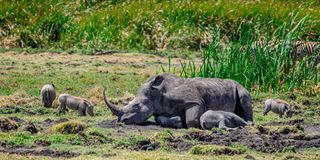Conservancies have seen rhino populations grow from 15 to 169

White rhino and her calf wallowing with warthogs at Lewa swamp. Photo|Rupi Mangat
What you need to know:
A wilderness that is tranquil, exciting, and amazing, has preserved the almost extinct animal
We are taking advantage of a free drive-through Lewa, the trailblazing wildlife conservancy, having spent a weekend at Il Ngwesi, the neighbouring conservancy belonging to the Il Lakipiak Maasai – ‘people of wildlife’. The two conservancies have a special bond as models of wildlife conservancies belonging to the local communities.
Lewa’s story begins with the rhino. When it seemed like Kenya was on the verge of losing her indigenous population of the black rhino in the 1980s, Lewa created the first rhino sanctuary in the country - Ngare Sergoi Rhino Sanctuary. With its gaining visitors, the sanctuary morphed into Lewa Wildlife Conservancy which boasts one of the highest wildlife densities in Kenya including 12 percent of the country’s black and white rhinos, and the world’s single largest population of Grevy’s zebra.
And we are not disappointed.
The first on our list is a lone white rhino on a high ridge on the sun-scorched grass plains mowing the land with his broad lips to the ground. That’s the easiest way to tell the two species apart for the black holds its head up to browse with its pointed lips.
Stephen Sankei our Maasai driver-guide from Ngwesi is on familiar ground. With no rain for close to two years in Kenya’s northern lands, endangered species like the white rhino need a little help with hay brought in to supplement their diet.
The murram road winds its way through the vast dry plains with the top of Mount Kenya giving a brief look. The rhinos are so at home here that one has its dung right by the side of the road announcing its territory.
The rhinos – both black and white – pop up here and there. If someone arrived from outer space, it would be difficult for them to imagine rhinos are a rare breed.
“Where are the lions?” asks Ejiro Osilama, new to the country and to the wilderness.
“It’s too hot for them to be out now,” replies Sankei. Living a life in the hot sun calls for adjustment. So the lions lounge in the shade during the heat of the day because unlike humans who sweat and cool down, these big cats lack sweat glands.
The plains show off the herds of finely stripped Grevy’s zebra, buffalos seated, vultures circling the air, dainty dikdiks, copper-coloured impalas and more.

Grevy's zebra at Lewa swamp. PHOTO: Rupi Mangat




